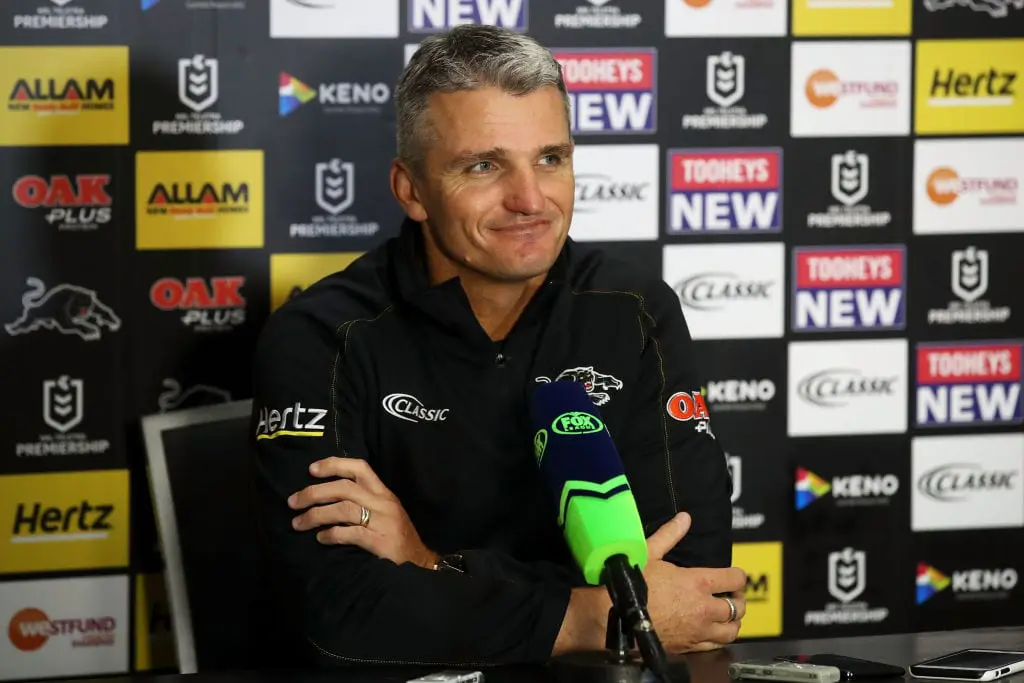It is interesting, or perhaps more appropriately, sad, how times change
For the period from the formation of rugby league in Australia (1908) until the start of the Super League War (1995), Australia treated international rugby league with great respect.
A Kangaroos jumper was seen as the highest honour in the game for nearly every immortal of Australian rugby league. Wally Lewis played a portion of the 1988 World Cup Final in Auckland with a broken arm, such was the respect with which the international game was held by the then Australian (and Queensland) captain.

Until the 1951 French team toured Australia and New Zealand travelling by air, every international touring side from the northern hemisphere came to Australia/New Zealand by way of a long arduous sea journey, which no player cherished, yet few refused. On arrival, they were welcomed with open arms.
Following the Second World War, the brilliant British Lions touring side of 1946 travelled to Australia over the course of a full month on the aircraft carrier HMS Indomitable (as no other sea transport was available). Once they landed in Perth, they were obliged, at short notice, to catch a dusty troop train for six days across the Nullarbor Plain to Sydney.
The players were only able to do all this (and without complaint), after the Australian Government had begged the British House of Commons to support the sending of a British Lions team to Australia so soon after the conclusion of the war.
In this way, rugby league took the lead in re-establishing post-war international sport between Australia and England – some two years prior to the Australian cricket team’s tour of England in 1948.
Sydney rugby league clubs (the same clubs that now make up a sizeable part of the NRL competition) fully supported these overseas tours from Great Britain, France and New Zealand.
Clubs would often be allocated 5,000 tickets each to sell to their supporters, with any residual tickets going back to the general public for sale. In most cases, few tickets were returned. This ensured bumper crowds for international rugby league which regularly exceeded those for both club and State matches.
International rugby league crowds represented a coming together of the rugby league community – an opportunity to cheer on club champions as they combined to defeat formidable overseas teams. Massive crowds attended games at the Sydney Cricket Ground.
In 1920, close to 70,000 spectators came to see a Sydney Metropolis side play the first game against the touring British Lions. In 1932, 70,204 attended the First Test between Australia and England.
The 1951 French team attracted an all-ticket crowd of over 67,000 to the Third Test, in which they thrashed Australia 35-14 to take the Test series 2-1. More than 70,000 attended the first test against Great Britain in 1962. Two crowds of over 60,000 attended the second and third Tests of the series against the British Lions in 1970.
International rugby league crowds generally sat in the area of 40,000 – 70,000 per match in Sydney depending on context and police caps on attendance – in a stadium that was essentially full with 50,000 in attendance. (In contrast, the Wallabies rugby union team never managed to attract a single crowd of 50,000 or more at the SCG in the entire period between the start of rugby league in 1908 and the end of the ground’s use as a major ground for the rugby codes in 1987.)
When called upon, the Sydney teams would happily release their players for reciprocal competitions overseas against the same nations. When the World Cup was inaugurated in France in 1954, Australia and New Zealand had been, together with the French and the British, instrumental in the very creation of the tournament.
There was never any question that Australia and New Zealand would not attend the 1954 World Cup and they travelled to France in full support of the tournament.
Fifteen World Cups in all have been played since 1954. Australia and New Zealand have competed in every one of them; always fully supported by the Australian and New Zealand Rugby Leagues.

Now, those same nations have unilaterally ruled themselves out of the 16th World Cup scheduled for England in October and November of this year. A World Cup which had already secured over $50 million dollars in funding from the British Government and which had been planned for in excess of five years. A World Cup expanded to 16 teams for the first time.
A World Cup which in the view of Clint Newton, Head of the Rugby League Players Association in Australia, has been the “most organised ever” in its engagement with players around safety and wellbeing issues.
"We have worked closely with Rugby League World Cup staff for some time now and we are committed to continuing those discussions regarding player health and safety protocols," Newton said.
"We have an obligation to advocate on behalf of all players to secure the best possible terms and conditions for the tournament, and this remains ongoing.
"For players representing remaining participating Nations, our priority will be to help ensure appropriate health and safety measures are in place, and also provide them with the relevant information to make an informed decision about participation.
"We had anticipated that players from Australia and New Zealand would have that same opportunity, which has unfortunately been taken away from them with last night's decision."
Clearly negatively influenced by many of the same clubs which once supported international rugby league – and thereby made it probably the strongest sport in Australia in many of those same years – the National Rugby League has this time deliberately undermined and sought to discredit the World Cup at every turn.
This has been overtly facilitated by the NRLs media partners in Australia.
It was reported that the organisers of the 2021 World Cup were given four minutes notice of the decision by the Australian and New Zealand rugby league bodies to withdraw. Four minutes – after five years of planning. The disrespect for the international game now displayed by both nations could never be better exemplified than by such an inexcusable course of action.
However, the damage to rugby league and the World Cup the ARLC/NZRL seemingly hope to inflict is not limited to this.
Not content with such an egregious method of operation, at least some NRL clubs, such as Penrith, have already begun attempting to pressure players from other nations not to compete in the World Cup. Whether this is a calculated and deliberate attempt to damage the World Cup, or merely myopic self-interest, is yet to be determined.
Ivan Cleary said as much.
"I wouldn't be comfortable (with them playing)," Cleary said.
"I think the ARL, the NRL and the NZRL have made a really brave but smart decision in this instance.
"But in terms of player welfare, there's too many risks and all things considered, I think the right decision has been made."

Some have suggested that the ARLC/NRL is motivated by an attempt to take over the apparatus of international rugby league from the very body which currently controls it, the International Rugby League. This would be aided by a ruined 2021 World Cup, a competition which is the lifeblood of the IRLs funding to develop the international game around the world.
The RLPA, who have already described the decision of Australia and New Zealand to pull out of the World Cup as “premature”, have a clear duty to protect the rights of all NRL players to compete in the competition should they wish to do so (and are able to do so safely).
Clint Newton of the RLPA told the writer last Saturday that the draft COVID protocols relating to the World Cup have only just been distributed to the competing 16 nations for review and comment. His view is that the process of involvement between the RLPA and the World Cup has been excellent and is “on-going”.
For Australia and New Zealand to then rely on safety as the basis for withdrawal, when the very documents governing safety have not yet been finalised, is completely disingenuous and an attempt to throw the rugby league public a fairly rotten red herring.
The expressed safety concerns cannot be taken seriously in such circumstances. They are merely cover for the NRL to protect its players from potential injury during international competition and to attempt to secure its own way in this matter.
In addition, the ARLC has refused to enforce the usual rule that clubs must make players available for international selection which, it is understood, is mandated in NRL contracts. The alleged basis for this is that the players need to rest. That this was a true basis for the decision was immediately discounted recently when discussions commenced about playing alternative internationals between the Kangaroos and the Kiwis in the Southern Hemisphere during the World Cup itself.
The IRL immediately announced through the media that any such games would be regarded as illegal and they reserved their right to take legal action to stop them. The discussions about alternative Test matches seemed to vanish as quickly as they appeared, but the contention that rest for players was a motivating factor in missing the World Cup also evaporated with those same discussions.
The timing of the announcement of the double withdrawal from the World Cup on the day of the commencement of the Olympics speaks for itself. It looks more and more like a brazen attempt to bury negative coverage of this issue under the current avalanche of daily Olympic news.
The Australian Rugby League Commission was formed with the intent that decisions be made in the best interests of rugby league. The decision to withdraw from the World Cup treats the charter of the ARLC with barely disguised contempt. The honourable thing to respect the legacy of the Kangaroos, Kiwis and all those players who “dug the well” is for both the Australian and New Zealand Rugby Leagues to reverse their decision and fully commit to the playing of the World Cup this year.
In the absence of having the fortitude to do so, they should not restrict any players in the NRL who qualify to play for other nations, including the burgeoning nations of the Pacific.
The undoubted growth which all participating players and nations receive from such organised and widespread international competition cannot be underestimated. If the ARLC chooses to allow NRL clubs to restrict players from competing, there will be no argument that they are acting in the best interests of rugby league; they will be actively working against it.























